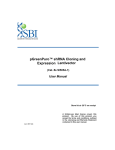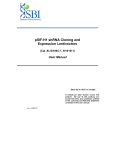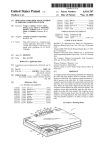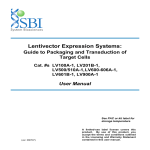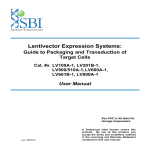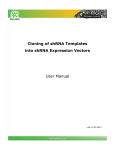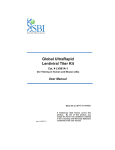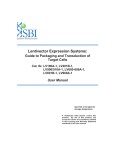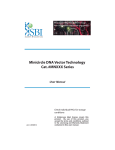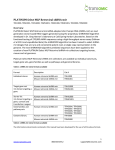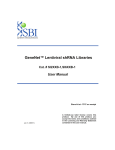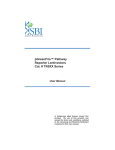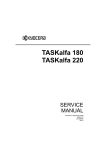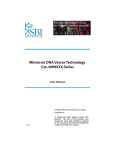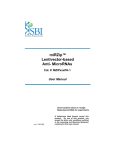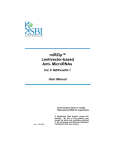Download pSIH-H1 shRNA Cloning and Expression Lentivectors
Transcript
pSIH-H1 shRNA Cloning and Expression Lentivectors (Cat. #s SI500A-1, SI501A-1, SI502A-1) User Manual Store kit at -20°C on receipt A limited-use label license covers this product. By use of this product, you accept the terms and conditions outlined in the Licensing and Warranty Statement contained in this user manual. (ver. 4-080514) pSIH-H1 shRNA Cloning and Expression Lentivectors Cat. #s SI500A-1 – SI502A-1 Contents I. Introduction and Background A. Purpose of this Manual B. Lentiviral shRNA Expression System C. pSIH shRNA Expression Lentivectors D. List of Components E. Additional Required Materials F. Safety Guidelines 2 3 4 6 6 8 II. Protocol A. shRNA Oligonucleotide Design and Synthesis B. Cloning of shRNA Template into pSIH Vector C. Identify Clones with shRNA Inserts D. Purify shRNA Lentivector Construct E. Transfection and Analysis of Silencing Efficiency 9 10 12 13 14 III. Troubleshooting A. Using the Positive Control B. Troubleshooting Specific Results IV. References 15 15 17 V. Appendix A. Maps and Features for pSIH Vectors B. Sequences of Luciferase Control shRNA Template Oligos C. Related Products D. Technical Support VI. Licensing and Warranty Statement 888-266-5066 (Toll Free) 650-968-2200 (outside US) 19 22 22 22 23 Page 1 System Biosciences (SBI) User Manual I. Introduction and Background A. Purpose of this Manual This manual provides details and information necessary to clone an shRNA template into the pSIH-H1 shRNA Cloning and Expression Vectors (pSIH1-H1-Puro, pSIH1-H1-H2Kk and pSIH1-H1-copGFP Vectors). Specifically, it provides critical instructions on designing and synthesizing shRNA templates, cloning the shRNA templates into the H1 expression cassette of pSIH-H1 Vectors, and verifying final vector constructs. This manual does not include information on packaging the pSIH-H1 Vector construct into pseudotyped viral particles or transducing your target cells of choice with these particles. This information is available in the user manual Lentivector Expression Systems: Guide to Packaging and Transduction of Target Cells, which is available on the SBI web site (www.systembio.com). Before using the reagents and material supplied with this system, please read the entire manual. B. Lentiviral shRNA Expression System Short double-stranded RNAs with sizes 19-29 bp can efficiently mediate gene silencing in mammalian cells by guiding sequence-specific degradation of target mRNA sequences (Bernstein 2001, Hammond 2000). Synthetic double-stranded siRNA molecules can be introduced into cells to suppress gene expression transiently. Alternatively, shRNA templates can be cloned into an shRNA expression vector—such as SBI’s FIV-based or HIVbased RNAi Cloning and Expression Lentivectors—and expressed in the cells of choice. Lentiviral expression vectors are the most effective vehicles for delivering genetic material to almost any mammalian cell—including non-dividing cells and whole model organisms. As with standard plasmid vectors, it is possible to introduce shRNA lentivector constructs in plasmid form into the cells with low-to-medium efficiency using conventional transfection protocols. However, by packaging the lentiviral shRNA construct in pseudoviral particles, you can obtain highly efficient transduction and heritable expression of siRNA—even with most difficult to transfect cells, like primary, stem, and differentiated cells. The expression construct transduced in cells is integrated into genomic DNA and provides stable, long-term expression of the target gene. Endogenously expressed siRNA effectors provide long-term silencing of the target gene and allow the researcher to generate cell lines and transgenic organisms with a stable knockdown phenotype for functional studies SBI offers a third generation of the most popular HIV-1 based lentivector expression system, consisting of three main components: (1) The lentiviral expression vector (e.g., pSIH1-H1-Puro™) (2) The lentiviral packaging plasmids (e.g., pPACKH1™ Packaging Plasmid mix) (3) A pseudoviral particle producer cell line (e.g., 293TN cells) The lentiviral expression vector contains the genetic elements responsible for packaging, transduction, stable integration of the viral expression construct into genomic DNA, and expression of the siRNA effector sequence. The packaging vector provides all the proteins Page 2 ver. 4-080514 www.systembio.com pSIH-H1 shRNA Cloning and Expression Lentivectors Cat. #s SI500A-1 – SI502A-1 essential for transcription and packaging of an RNA copy of the expression construct into recombinant viral particles. For production of a high titer of viral particles, producer cells (e.g., HEK 293 cells) need to be transiently co-transfected with the expression and packaging vectors. Expression constructs packaged in pseudoviral particles are secreted by producer cells in culture media and could be used directly to transduce expression construct in target cells. Following transduction into the target cells, this expression construct is reverse transcribed, integrated into the genome of the target cell, and provides a high level of expression of siRNA. For a detailed description of SBI’s Lentivector expression system, please refer to the Lentivector Expression Systems: Guide to Packaging and Transduction of Target Cells user manual. C. pSIH shRNA Expression Lentivectors The pSIH expression system is a third generation of HIV-based expression lentivectors developed for gene therapy applications (Sodroski, J.G., 1997, 1999, Federico, 2003, Heiser, 2004, Machida, 2003). See section F for safety guidelines. The pSIH vectors (see detailed functional map in Appendix) provide the following features: • H1 expression cassette provides constitutive and efficient RNA polymerase IIIdependent transcription of shRNA transcripts in wide range of cell lines. • CMV promoter promotes high level of expression of copGFP (fluorescent reporter), puromycin-N-acetyl transferase (drug selectable marker) or truncated H2Kk protein (cell surface marker) for detection and selection of transduced cells. • Hybrid RSV-5’LTR promoter provides a high level of expression of the full-length viral construct in 293 cells. • Genetic elements (cPPT, GAG, LTRs) necessary for packaging, transducing, and stable integration of the viral expression construct into genomic DNA. • SV40 origin for stable propagation of the pSIH plasmid in 293 producer cells. • The pUC origin for high copy replication and maintenance of the plasmid in E.coli cells. • The ampicilin-resistance gene for selection in E.coli cells. • WPRE element enhances stability and translation of the CMV-driven transcripts. • The SV40 polyadenylation signal enables efficient termination of transcription and processing of recombinant transcripts. The pSIH1-H1-Puro Vector (Cat. # SI500A-1) contains a puromycin resistance gene to enable drug selection of target cells stably expressing the siRNA. The pSIH1-H1-copGFP Vector (Cat. # SI501A-1) contains a copGFP gene. CopGFP is a novel fluorescent protein, derived from copepod plankton (Panalina sp.), which is similar to EGFP but has a brighter color. This gene serves as a fluorescent reporter for the transfected or transduced cells. The non-functional murine cell surface marker H-2Kk with a truncated cytoplasmic domain provides a unique opportunity to detect transduced cells with FITC-labeled H-2Kk Ab or select H-2Kk-positive cells with Miltenyi’s magnetic beads in wide range of human and mouse cell lines (except AKR/J and CBA/Ca mouse strain)(www.miltenyibiotech.com). 888-266-5066 (Toll Free) 650-968-2200 (outside US) Page 3 System Biosciences (SBI) User Manual Two approaches have been developed for in vivo expression of siRNA from plasmid and viral vectors. In one approach, the sense and anti-sense strands are transcribed separately from two independent promoters and form the siRNA duplex (Lee 2002, Miyagishi 2002). With the second approach, a single-stranded shRNA sequence with a fold-back stem-loop structure (also known as a “hairpin”) is expressed from a single promoter (Abbas-Terki 2002, Qin 2003, Wiznerowicz 2003). This sequence is then converted into double-stranded siRNA after intracellular processing cleaves the loop (Brummelkamp 2002, Paddison 2002). In both approaches, the siRNA molecules are transcribed from constitutive RNA polymerase III promoters (i.e., U6 and/or H1) and terminated with TTTTT (T5) sequences (Tuschl 2002). The U6 and H1 promoters are different in size but contain the same conserved sequence elements (Myslinski 2001). The pSIH-H1 Vectors are designed to express a single-stranded shRNA sequence with a fold-back stem-loop structure (also known as a “hairpin”) from a RNA polymerase III H1 promoter (Abbas-Terki 2002, Qin 2003, Wiznerowicz 2003). The hairpin-type siRNA (shRNA) template oligonucleotides need to be cloned into unique BamHI/EcoRI sites located just downstream of an H1 promoter (Figure 1). The pSIH-H1 vectors need to be linearized by restriction digest with BamHI and EcoRI, and purified to remove the stuffer fragment. When linearized, the vector contains two unique 5’ overhangs to facilitate directional cloning of shRNA template oligos with minimal self-ligation background (Figure 1). When the shRNA construct is expressed from constitutive H1 promoter and terminated with the TTTTT sequence, the shRNA transcript folds into the hairpin structure, which is recognized by the DICER enzyme, cleaved to form a functional ds siRNA and transferred to a RISC complex for selective digestion of complementary target mRNAs ((Brummelkamp 2002, Paddison 2002) (Figure 2). Two PCR primers are designed for regions flanking the shRNA insert in order to provide a simple way for screening of plasmid clones for the presence of shRNA inserts by PCR (Figure 2). Page 4 ver. 4-080514 www.systembio.com pSIH-H1 shRNA Cloning and Expression Lentivectors Cat. #s SI500A-1 – SI502A-1 Fig. 1. Design of the single-promoter pSIH-H1 shRNA expression cassette. The dotted lines at the top of the figure indicate the position of the “stuffer fragment” that is removed during linearization by digesting the vector with BamHI/EcoRI. Your shRNA template sequence should be designed to directionally insert between the BamHI and EcoRI nucleotide overhangs (i.e., sticky ends). This example shows the siRNA sequence targeting the p53 gene. Fig. 2. Example shRNA template construct targeting the p53 gene. The nucleotides for the specific siRNA sequence targeting the p53 gene are shown in capital letters. The shRNA sense and antisense sequences flank the region coding for the loop structure. In addition, a terminator sequence for the RNA polymerase III is included after the antisense portion. The Forward and Reverse arrows refer to the PCR primers contained in this product to confirm positive clones. After transcription, a stem-loop-stem shRNA molecule is produced. This molecule is processed by the DICER enzyme to generate a double-stranded siRNA effector. 888-266-5066 (Toll Free) 650-968-2200 (outside US) Page 5 System Biosciences (SBI) User Manual D. List of Components Each pSIH-H1 Vector Kit provides enough plasmid for 20 ligation reactions: • pSIH1-H1-Puro shRNA Expression Lentivector (Cat. # SI500A-1) 50 µl 25 µl 25 µl 25 µl • pSIH1-H1-copGFP shRNA Expression Lentivector (Cat. # SI501A-1) 50 µl 25 µl 25 µl 25 µl • pSIH1-H1-Puro vector (non-linearized, 0.2 µg/µl) Luciferase Control shRNA Template Oligonucleotide Mix (20 µM each) ForwardH PCR Primer (5’-AATGTCTTTGGATTTGGGAATCTTAT-3’; 10 µM) ReverseH PCR Primer (5’-TGGTCTAACCAGAGAGACCCAGTA-3’; 10 µM) pSIH1-H1-copGFP vector (non-linearized, 0.2 µg/µl) Luciferase Control shRNA Template Oligonucleotide Mix (20 µM each) ForwardH PCR Primer (5’-AATGTCTTTGGATTTGGGAATCTTAT-3’; 10 µM) ReverseH PCR Primer (5’-TGGTCTAACCAGAGAGACCCAGTA-3’; 10 µM) pSIH1-H1-H2Kk shRNA Expression Lentivector (Cat. # SI502A-1) 50 µl 25 µl 25 µl 25 µl pSIH1-H1-H2Kk vector (non-linearized, 0.2 µg/µl) Luciferase Control shRNA Template Oligonucleotide Mix (20 µM each) ForwardH PCR Primer (5’-AATGTCTTTGGATTTGGGAATCTTAT-3’; 10 µM) ReverseH PCR Primer (5’-TGGTCTAACCAGAGAGACCCAGTA-3’; 10 µM) The kits are shipped in dry ice and should be stored at -20°C upon receipt. Properly stored kits are stable for 12 months from the date received. E. Additional Required Materials For Phosphorylation and Annealing of shRNA Template Oligonucleotides • T4 Polynucleotide Kinase and 10X reaction buffer (Recommended: New England BioLabs T4 Polynucleotide Kinase, 10 U/µl, Cat. # M0201S. • rATP (Recommended: GE/Amersham, Cat. # 27-2056-01) For Linearizing shRNA Expression Vector • BamHI and EcoRI restriction enzymes (Recommended: New England BioLabs, EcoRI (20 U/µl, Cat. # R0101. BamHI (20 U/µl, Cat. #R0136S)) • Qiagen Qiaquick PCR Purification Kit. Cat No. 28104 For Ligating and Transforming shRNA Constructs • T4 DNA Ligase and 10X ligation reaction buffer (Recommended: New England BioLabs, T4 DNA Ligase, 400 U/µl. Cat. # M0202S. Before using, dilute T4 DNA-ligase 10-fold with 1X T4 DNA ligase buffer to 40 U/µl.) • Competent E. coli cells (RecA-) Page 6 ver. 4-080514 www.systembio.com pSIH-H1 shRNA Cloning and Expression Lentivectors • Cat. #s SI500A-1 – SI502A-1 (Recommended: Invitrogen, OmniMAX™ 2 T1 cells, Cat. # C8540-03) Petri plates containing LB Agar media with 50 µg/ml Ampicillin For Screening shRNA Inserts • Taq DNA polymerase, and 10X reaction buffer (Recommended: Clontech Titanium™ Taq DNA polymerase, Cat. # 639208) • dNTP mix (Recommended: GE/Amersham, dNTP set, Cat. # 27-2035-01) • PCR machine • 3% 1X TAE Agarose gel For Purifying shRNA Constructs after Cloning • Plasmid purification kit (Recommended: QIAGEN Endotoxin-free Plasmid Kit. The following kit combinations can be used for Midi scale preparation of endotoxin-free DNA: ¾ QIAfilter Plasmid Midi Kit, Cat. # 12243, and EndoFree Plasmid Maxi Kit, Cat. # 12362 ¾ QIAfilter Plasmid Midi Kit, Cat. # 12243, and EndoFree Plasmid Buffer Set, Cat. # 19048 Please visit the QIAGEN website to download the specialized protocol that is not contained in the user manual: ¾ http://www1.qiagen.com/literature/protocols/pdf/QP15.pdf Transfection of pSIH Constructs into Target Cells • Transfection reagent (Recommended: Lipofectamine™ 2000, Invitrogen, Cat # 11668-027) Packaging of pSIH Constructs in Pseudoviral Particles • pPACKH1 Lentivector Packaging Kit (SBI, Cat # LV500A-1) • 293TN Producer Cell Line (SBI, Cat # LV900A-1; or ATCC, 293T/17, Cat # CRL-11268) • Lipofectamine™ Transfection Reagent ( Invitrogen, Cat # 18324-111) • Plus™ Reagent (Invitrogen, Cat # 11514-015) 888-266-5066 (Toll Free) 650-968-2200 (outside US) Page 7 System Biosciences (SBI) User Manual F. Safety Guidelines SBI’s pSIH lentivectors together with the pPACKH1 packaging plasmids comprises a thirdgeneration HIV-1-based cloning vector system. These lentivectors are based on the vectors developed for gene therapy applications by Dr. J. G. Sodroski (US patent #5,665,577 and # 5,981,276). This system is designed to maximize its biosafety features including: • Deletion in the enhancer of U3 region of 3’LTR ensures self-inactivation of lentiviral construct after transduction and integration into genomic DNA of the target cells. • RSV promoter upstream of 5’LTR in pSIH expression vector allows efficient Tatindependent production of viral RNA, reducing the number of genes from HIV-1 that are used in this system. • Number of HIV-1 viral genes necessary for packaging, replication and transduction is reduced to three (gag, rev and pol), and these genes are expressed from different plasmids lacking packaging signals and significant homology to pSIH expression vectors, VSV-G expression vector, or each other to prevent generation of recombinant replication-competent virus. • None of the HIV-1 genes (gag, pol, rev) will be present in the packaged viral genome, as they are expressed from packaging plasmids lacking packaging signal--therefore, the lentiviral particles generated are replication-incompetent. • Pseudoviral particles will carry only the expression construct of your target gene. • The lentiviral particles produced in this system are pseudotyped with envelope G glycoprotein from Vesicular Stomatitis Virus. Despite the above safety features, use of HIV-based vectors falls within NIH Biosafety Level 2 criteria. For a description of laboratory biosafety level criteria, consult the Centers for Disease Control Office of Health and Safety Web site at http://www.cdc.gov/od/ohs/biosfty/bmbl4/bmbl4s3.htm. It is also important to check with the health and safety guidelines at your institution regarding the use of lentiviruses and always follows standard microbiological practices, which include: • Wear gloves and lab coat all the time when conducting the procedure; • All procedures are performed carefully to minimize the creation of splashes or aerosols. • Work surfaces are decontaminated at least once a day and after any spill of viable material. • All cultures, stocks, and other regulated wastes are decontaminated before disposal by an approved decontamination method such as autoclaving. Materials to be decontaminated outside of the immediate laboratory are to be placed in a durable, leakproof container and closed for transport from the laboratory. Page 8 ver. 4-080514 www.systembio.com pSIH-H1 shRNA Cloning and Expression Lentivectors Cat. #s SI500A-1 – SI502A-1 II. Protocol A. shRNA Template Oligonucleotide Design and Synthesis Typically, 4 or 5 target sequences in the gene of interest need to be selected and tested to identify functional siRNAs with at least 70% silencing efficiency of target mRNA. Although there is no standard rule for selecting the target mRNA binding sites for siRNA sequences, we have found the following criteria useful: • 19-29 nt in length, usually longer oligos (25-27 nt) are more robust and give better silencing efficiencies although 19 nt oligos could be also used. • Unique sequence with less than 70% Homology with other mRNA sequences in a RefSeq database). Especially avoid homology to other non-target mRNA sequences in central portion of siRNA, flanking sequences usually tolerate mismatches (especially G:U and A:C) without reduction in silencing efficiency • 40%-55% GC content. • No more than 4 consecutive A’s or T’s. • No more than 5 consecutive G’s or C’s. • No thermodynamically stable secondary structure (< 0 Kcal/mol). • A 5’-terminus (3-5 flanking nucleotides) on the anti-sense strand should be more AT-rich than the 3’-terminus. The template sequences coding for the shRNA targeted to each selected target site must contain both the sense and anti-sense strand, and be designed to form a stem-loop structure when transcribed. In addition, both the top and bottom strands of the entire shRNA sequence (sense-loop-antisense-terminator) must be synthesized and annealed to make a double-stranded DNA sequence that can be cloned into the pSIH vector. The features of the oligonucleotides coding for the shRNA template sequence should include the following: (1) The 19-29 nucleotide sense and antisense mRNA sequences. Usually longer siRNAs (25-27 nt) have better silencing efficiencies although 19-nt oligos are more commonly used. For the design of 27-nt oligos, we recommend the program available at Dr. Gregory Hannon’s web site (http://katahdin.cshl.org:9331/homepage/siRNA/RNAi.cgi?type=shRNA). The program is designed to incorporate a few G-U mismatches in the sense portion of stem that will help to stabilize hairpins during propagation in bacteria. (2) A hairpin loop sequence between sense and antisense portion. The 9-nt loop sequence (5'-TTCAAGAGA-3') is most commonly used in RNA silencing experiments (Brummelkamp 2002), but we have used a 12-nt sequence (5'-CTTCCTGTCAGA-3'), which generates similar results. Loop sequences of 3 to 15 nucleotides have been used successfully by different investigators. (3) A TTTTT terminator sequence for RNA polymerase III. 888-266-5066 (Toll Free) 650-968-2200 (outside US) Page 9 System Biosciences (SBI) User Manual (4) A BamHI and EcoRI restriction site overhang sequences for directional cloning of annealed shRNA template oligonucleotides into the pSIH-H1 vector. (5) Using of initiation G nucleotide in the first position of sense portion of shRNA is not necessary, as RNA polymerase III could initiate transcription from any +1 nucleotide of H1 promoter. The top and bottom strands of the shRNA template oligonucleotides should be designed to look like the following diagram after annealing (See also Figure 1): BamHI 5’ Sense Strand Loop Antisense Strand RNA Pol III Terminator EcoRI GATCCNNNNNNNNNNNNNNNNNNNCTTCCTGTCAGANNNNNNNNNNNNNNNNNNNTTTTTG 3’ 3’ GNNNNNNNNNNNNNNNNNNNGAAGGACAGTCTNNNNNNNNNNNNNNNNNNNAAAAACTTAA 5’ For each selected template sequence, two complementary oligonucleotides—the “top” strand and complementary bottom strand—need to be synthesized, phosphorylated and annealed before ligation step. A 50 µM scale reaction for oligonucleotide synthesis with regular desalting purification is sufficient for cloning into the pSIH-H1 Vectors. For the best cloning efficiency, we recommend to phosphorylate oligonucleotides using T4 polynucleotide kinase. The phosphorylation procedure is shown below in step B.1. B. Cloning of shRNA Template Oligonucleotides into pSIH-H1 Vector 1. Linearize the pSIH vector with EcoRI/BamHI Set up a 50 µl restriction digest as follows: a. 33.8 5 0.2 0.5 0.5 10 50 b. c. 2. µl µl µl µl µl µl µl Deionized water 10x NEB 3 buffer 100x BSA BamHI (20 U/µL, NEB) EcoRI (20 U/µL, NEB) pSIH vector (0.2 µg/µL) Total volume Digest overnight at 37°C. Purify linearized plasmid DNA using Qiagen Qiaquick PCR purification kit. Elute purified DNA in 30 µL EB buffer. Phosphorylate and Anneal the shRNA Template Oligonucleotides Note: This protocol was developed for regular non-phosphorylated oligos. If your oligonucleotides are already phosphorylated, dilute them to 10 µM in 1X T4 polynucleotide kinase buffer, heat at 95°C for 2 min and anneal as in steps 1.d-1.e. Page 10 ver. 4-080514 www.systembio.com pSIH-H1 shRNA Cloning and Expression Lentivectors Cat. #s SI500A-1 – SI502A-1 a. Dissolve the shRNA template oligonucleotides in an appropriate amount of deionized water to a final concentration of 20 µM. b. Set up 20 µl phosphorylation/annealing reactions for each experimental shRNA template and Luciferase Control Template Mix as follows: 1 1 2 2 12 2 20 µl µl µl µl µl µl µl Top Strand shRNA template oligo (20 µM) * Bottom Strand shRNA template oligo (20 µM) * 10X T4 Polynucleotide Kinase Buffer 10 mM ATP Deionized water T4 Polynucleotide Kinase (10 U/µl) Total volume * For the insert-minus control, use 2 µl deionized water in place of the top and bottom strands. For the positive control, use 1 µl of the Luciferase Control shRNA Template Mix and 1 µl deionized water. c. d. e. Incubate the phosphorylation reaction at 37°C for 30 minutes in a thermocycler. Heat the reaction mix to 95°C for 2 min in a thermocycler. Turn off the thermocycler and let it cool to room temperature. f. Use 0.5 µl of 1 µM shRNA template for the following ligation reaction. 3. Ligate the shRNA Template into Linearized pSIH-H1 Lentivector a. Set up 10 µl ligation reactions for each phosphorylated shRNA template as follows: 1.0 0.5 1.0 6.5 1.0 10.0 µl µl µl µl µl µl Linearized pSIH-H1 Vector (50 ng/µl) Phosphorylated ds shRNA template (step 1; 1µM) * 10X T4 DNA Ligase Buffer Deionized water T4 DNA ligase (40 U/µl) ** Total volume * For negative control use insert-minus and for positive control use Luciferase shRNA template from step 1. ** Dilute T4 DNA ligase (400 U/µl) 10-fold to 40 U/µl with 1X T4 DNA ligase buffer if you are using New England Biolabs enzyme. b. 4. Incubate the ligation reaction at 16°C for 1-2 hrs. Transform E. coli with the ligation product a. For each experimental shRNA template, use the whole volume of ligation product for transformation. 888-266-5066 (Toll Free) 650-968-2200 (outside US) Page 11 System Biosciences (SBI) User Manual b. Follow the manufacturer’s protocol for transforming the competent cells. c. Plate an appropriate amount of cells on LB plates with 50 µg/ml ampicillin and grow overnight at 37°C. You could expect to get at least 10-fold more colonies in experimental samples in comparison with negative control (vector-only ligation reaction). d. C. Identify clones with the target shRNA template 1. Prepare colony cultures a. Randomly pick up 10 well-separated colonies from each plate, and grow each clone in 100 µl of LB Broth with 50 µg/ml ampicillin at 37°C for 2 hours with shaking. b. Take 1 µl of each bacteria culture for PCR screening (see C.2) and continue to grow the culture for another 6 hours. Store the bacterial culture at 4°C. c. Page 12 ver. 4-080514 www.systembio.com pSIH-H1 shRNA Cloning and Expression Lentivectors 2. Cat. #s SI500A-1 – SI502A-1 Screen for shRNA template inserts a. Prepare a PCR master mix for each clone you would like to screen for the presence of a shRNA template insert as follows: 1 rxn 0.5 µl 0.5 µl 0.5 µl 2.5 µl 19.5 µl 0.5 µl 24.0 µl 10 rxn 5 µl 5 µl 5 µl 25 µl 195 µl 5 µl 240 µl Composition ForwardH PCR Primer (10 µM) ReverseH PCR Primer (10 µM) 50X dNTP mix (10 mM of each) 10X PCR Reaction Buffer Deionized water Taq DNA Polymerase (5 U/µl) Total volume b. Mix the master mix very well and aliquot 24 µl into each well of a 96-well PCR plate or individual tubes. c. d. Add 1 µl of each bacterial culture from C.1 into each well or tube from C.2.b. Mix. Proceed with PCR using the following program: 94°C, 4 min 1 cycle 94°C, 0.5 min, then 68°C, 1 min 25 cycles 68°C, 2 min 1 cycle e. Take 5 µl of PCR product from step d and run it on a 3% agarose/EtBr gel in 1X TAE buffer. Clones without an insert will yield a product of 105 bp. The expected size of amplified clones with a shRNA template insert should be about 150-170 bp depending on expected length of the shRNA template insert (see Figure 2 for details). Some clones may not yield a product. These are results of recombination during propagation in E. coli. f. Confirm identity of shRNA template inserts by sequence analysis of positive PCR products using the ForwardH PCR primer. D. Purify shRNA Lentivector Construct a. b. Take 15-20 µl of each positive bacteria culture from Step C.1.c, inoculate each clone in 25 ml of LB broth media with 50 µg/ml ampicillin, and grow overnight at 37°C with shaking. Purify shRNA lentivector construct plasmid DNA in Midi scale using an Endotoxin-free plasmid purification kit. (see section I.E, Additional Required Materials) 888-266-5066 (Toll Free) 650-968-2200 (outside US) Page 13 System Biosciences (SBI) User Manual E. Transfection and Analysis of Silencing Efficiency If you are planning to use SBI’s pSIH-H1 shRNA constructs for viral delivery, we recommend first to screen the shRNA constructs generated in section D to determine their effectiveness at knocking down expression of the target gene. To rapidly screen the shRNA lentivector constructs in plasmid form, you can deliver and express them in HeLa or HEK 293 cells using chemical transfection. For example, with these cells the Lipofectamine™ Reagent (Invitrogen, Cat. # 18324-111) with Plus™ Reagent (Invitrogen, Cat. # 11514-015) works well in our hands. Alternatively, you can use your target cells for this analysis. If you have already established a transfection method for your target cells, use your established conditions. If you do not have an established transfection protocol, we recommend you compare efficiencies of several transfection procedures (e.g., Invitrogen’s Lipofectamine™ 2000, Cat. # 11668-027; Roche, FuGENE 6, Cat. # 11 815 091 001). The goal of these experiments is to achieve at least 90-95% transfection efficiency of target cells, which can be measured by analysis of GFP-positive cells if you are using constructs with copGFP reporters or H2Kk-positive cells for constructs in the pSIH1-H1-H2kk vector. For shRNA knockdown studies using transfection, it is important to optimize the selected transfection protocol and then keep the parameters constant to ensure reproducible results. Depending on what is appropriate for your target gene, the silencing efficiency of different shRNA constructs can be estimated by determining the concentration of target mRNA using RT-PCR, assessing the amount of target protein by Western blot or ELISA, or assaying for activity of the target protein. Usually shRNA constructs with 70-80% silencing efficiency are suitable for gene functional analysis studies. Once you identify a functional shRNA construct, you can package this construct into pseudoviral particles, and efficiently transduce these shRNA constructs into target cells of your choice. For this purpose, you will need to purchase the pPACKH1 Lentivector Packaging Kit (SBI, Cat. # LV500A-1) and 293TN Producer Cell Line (SBI, Cat. # LV900A1). The pPACKH1 User Manual “Lentivector Expression Systems: Guide to Packaging and Transduction of Target Cells” includes the procedural information for packaging the shRNA lentivector constructs. This user manual is also available on the SBI web site (www.systembio.com). Although you can create stable transfectants with the pSIH constructs using standard transfection and selection protocols, transduction of the lentiviral pSIH shRNA constructs using packaged pseudoviral particles is the most efficient way to express siRNA in wide range of cells, including dividing, non-dividing, and hard-to-transfect varieties. Page 14 ver. 4-080514 www.systembio.com pSIH-H1 shRNA Cloning and Expression Lentivectors Cat. #s SI500A-1 – SI502A-1 III. Troubleshooting A. Using the Positive Control The Luciferase Control shRNA Template Oligonucleotide Mix is a mixture of complementary DNA strands with sticky ends (5’GATC, and 5’TTAA) to match with the BamHI and EcoRI ends on the linearized pSIH-H1 Vector. The 64-base hairpin shRNA template sequence, consisting of 26-base sense, 12-base loop, and 26-base antisense sequences, targets the wild-type Firefly Luciferase gene. When run in parallel with your experimental annealed double-stranded shRNA oligonucleotides, Luciferase Control shRNA Template Oligonucleotide Mix serves as positive control to check if your phosphorylation and ligation reactions and transformation procedure work well. Using the protocol described in II.B, ligation with this control insert mix should provide at least 5-10 times more colonies than ligation of the vector without an insert. The control pSIH construct with the Luciferase shRNA template can also be used to monitor the efficiency of target Luciferase mRNA silencing. A cell line with a constant expression level of Luciferase can easily be generated. The level of Luciferase expression should be reduced at least 5-fold after transfection or transduction of the pSIH-H1 Luciferase shRNA construct in the Luciferase reporter cell line. B. Troubleshooting Specific Results 1. Getting Few or No Clones Check design of the shRNA template Check the sequence of the shRNA oligonucleotides to ensure that, after sense/anti-sense annealing, the ends present the 5’ GATC and 5’ TTAA overhangs for proper annealing with the restricted ends of linear pSIH-H1 Vector. Also, confirm that the top and bottom strand sequences are complementary to each other. Check annealing To ensure a high percentage (80%) of double-stranded DNA after annealing, check the concentration of shRNA template oligonucleotides using a spectrophotometer and mix equal molar amounts of each strand. To check annealing, run 5 µl of annealed insert (from step B.1.f) using a 12% polyacrylamide gel and compare the band’s location with that of the original single-stranded oligonucleotides. Confirm oligonucleotides were correctly synthesized Verify the size of the oligonucleotides using a 12% native polyacrylamide gel. Check quality of T4 polynucleotide kinase and T4 DNA ligase Test the activity of your ligase and reaction buffer using a different vector and insert. Test the activity of T4 polynucleotide kinase by labeling annealed control Luciferase with 32P-γATP. Replace the reagents if they show poor activity. 888-266-5066 (Toll Free) 650-968-2200 (outside US) Page 15 System Biosciences (SBI) User Manual Ensure there are no ligation inhibitors present EDTA and high salt can inhibit ligation reactions. Make sure that your ds shRNA template oligonucleotide concentration is 1µM and use 0.1-1 µl of this oligonucleotide in ligation reaction. Higher concentration of ds shRNA template oligonucleotide could reduce yield of shRNA lentivector construct. Check the quality of the competent cells Handle the competent cells gently. Many cells cannot be refrozen once thawed. The quality of the competent cells can be tested by transforming with any circular plasmid. Check antibiotic selection The plates used for cloning should contain 50-100 µg/ml ampicillin in the media. You can check the activity of the antibiotic by mixing wild-type E. coli with small numbers of E. coli that have been successfully transformed with any plasmid containing the AmpR gene. 2. Too many clones without shRNA insert Confirm pSIH vector was completely linearized. Run a small aliquot of the EcoRI/BamHI digested vector. A single band should be observed, if not, redigest and gel purify. Confirm activity of the EcoRI and BamHI restriction enzymes Perform a small scale test digestion on the pSIH vector with EcoRI and BamHI separately to confirm they both are able to linearize the vector. If not, replace the enzyme. 3. No product was amplified from selected clones Confirm activity of the Taq DNA polymerase Test the activity of the enzyme reaction by amplifying a known sequence from any plasmid DNA. Replace the reagents if they demonstrate poor activity. Ensure that you have not picked plasmids without shRNA template insert. Colonies without an insert will yield a product of about 100 bp. Please also note that, due to recombination (even when using recA bacteria), you will not be able to amplify any product from plasmid isolated from some of the colonies. Always confirm that you have rignt insert by sequence analysis of PCR product or sequencing of saran expression cassette in purified lentivector constructs. Page 16 ver. 4-080514 www.systembio.com pSIH-H1 shRNA Cloning and Expression Lentivectors Cat. #s SI500A-1 – SI502A-1 IV. References General references: Abbas-Terki, Blanco-Bose, N. Deglon, Pralong, W., and Aebischer, P. (2002) Lentiviral-mediated RNA interference. Hum. Gene Ther. 13:2197-2201 Buchschacher, G.L., and Wong-Staal, F. (2000) Development of lentiviral vectors for gene theraphy for human diseases. Blood. 95:2499-2504. Burns, J.C., Friedmann, T., Driever, W., Burrascano, M., and Yee, J.K. (1993) Vesicular stomatitis virus G glycoprotein pseudotyped retroviral vectors: concentration to a very high titer and efficient gene transfer into mammalian and non-mammalian cells. Proc. Natl. Acad. Sci. USA. 90:8033-8034. Cann, A.J.(ed). (2000) RNA Viruses. A Practical Approach. Oxford Univ. Press. Dull, T., Zufferey, R., Kelly, M., Mandel, R.J., Nguyen, M., Trono, D., and Naldini, L. (1998) A thirdgeneration lentivirus vector with a conditional packaging system. J. Virol. 72:8463-8471. Gould, D.J. and Favorov, P. (2003) Vectors for the treatment of autoimmune diseases. Gene Therapy 10:912-927. Lee, N.S., Dohjima, T., Bauer, G., Li, H., Li, M-J., Ehsani, A., Salvaterra, P., and Rossi, J. (2002) Expression of small interfering RNAs targeted against HIV-1 rev transcripts in human cells. Nature Biotechnol. 20:500-505 Morgan, R.A., Cornetta, K. and Anderson, W.F. (1990) Application of the polymerase chain reaction in retroviral-mediated gene transfer and the analysis of gene-marked human TIL cells. Hum. Gene Ther. 1:135-149. Pfeifer, A., Kessler, T., Yang, M., Baranov, E., Kootstra, N., Cheresh, D.A., Hoffman, R.M. and Verma, I.M. (2001) Transduction of liver cells by lentiviral vectors: Analysis in living animals by fluorescence imaging. Mol. Ther. 3:319-322. Qin, X.F., An, D.S., Chen, I.S., and Baltimore, D. (2003) Inhibiting HIV-1 infection in human T cells by lentiviral-mediated delivery of small interfering RNA against CCR5. Proc. Natl. Acad. Sci. USA 100:183188 Quinn, T.P., and Trevor, K.T. (1997) Rapid quantitation of recombinant retrovirus produced by packaging cell clones. Biotechniques 23:1038-1044. Sodroski, J.G. Vector containing HIV packaging sequences, packging defective HIV vectors, and uses thereof. US patent #5,665,577. (1997) September 9. Sodroski, J.G. Vectors containing HIV packaging sequences, packaging defective HIV vectors, and uses thereof. US patent # 5,981,276. (1999) November 9. Sui, G., Soohoo, C. Affar, E.B., Gay, F., Forrester, W.C., and Shi, Y. (2002) A DNA vector-based RNAi technology to suppress gene expression in mammalian cells. Proc. Natl. Acad. Sci. U.S.A 99:5515-5520 Wiznerowicz, M., and Trono, D. (2003) Conditional suppression of cellular genes: lentivirus vectormediated drug-inducible RNA interference. J. Virology 16: 8957-8961 888-266-5066 (Toll Free) 650-968-2200 (outside US) Page 17 System Biosciences (SBI) User Manual HIV vector reviews: Federico, M. Methods in Molecular Biology. Volume 229. Lentivirus gene engineering protocols. (2003), Humana Press. Heiser, W.C. (ed). Methods in Molecular Biology. Volume 246. Gene delivery to mammalian cells. Volume 2: Viral Gene transfer techniques. (2004), Humana Press. Machida, C.A. (ed). Viral vectors for gene therapy. Methods and Protocols. (2003), Humana Press. Naldini L. Lentiviruses as gene transfer agents for delivery to non-dividing cells. Curr Opin Biotechnol. 1998 Oct; 9(5): 457-63. Page 18 ver. 4-080514 www.systembio.com pSIH-H1 shRNA Cloning and Expression Lentivectors Cat. #s SI500A-1 – SI502A-1 V. Appendix A. Maps and Features for pSIH-H1 Vectors Feature RSV/5'LTR gag RRE cPPT CMV promoter Puro WPRE 3' ∆LTR (∆U3) H1 RNA promoter SV40 Poly-A SV40 Ori pUC Ori AmpR Location* Function Hybrid RSV promoter-R/U5 long terminal repeat; 7-414 required for viral packaging and transcription 567-919 Packaging signal Rev response element binds gag and involved in 1076-1309 packaging of viral transcripts Central polypurine tract (includes DNA Flap 1798-1916 region) involved in nuclear translocation and integration of transduced viral genome Human cytomegalovirus (CMV)--constitutive 1922-2271 promoter for transcription of puromycin Puromycin-resistant marker for selection of the 2279-2878 transfected/transduced cells Woodchuck hepatitis virus posttranscriptional 2885-3425 regulatory element--enhances the stability of the viral transcripts Required for viral reverse transcription; selfinactivating 3' LTR with deletion in U3 region 3564-4038 prevents formation of replication-competent viral particles after integration into genomic DNA RNA polymerase III promoter for expression of 3602-3818 siRNA insert 4110-4241 Transcription termination and polyadenylation Allows for episomal replication of plasmid in 4250-4396 eukaryotic cells 4766-5439 (C) Allows for high-copy replication in E. coli Ampicillin resistant gene for selection of the 5584-6444 (C) plasmid in E. coli * The notation (C) refers to the complementary strand. 888-266-5066 (Toll Free) 650-968-2200 (outside US) Page 19 System Biosciences (SBI) Feature RSV/5'LTR gag RRE cPPT CMV promoter copGFP WPRE 3' ∆LTR (∆U3) H1 RNA promoter SV40 Poly-A SV40 Ori pUC Ori AmpR User Manual Function Hybrid RSV promoter-R/U5 long terminal repeat; 7-414 required for viral packaging and transcription 567-919 Packaging signal Rev response element binds gag and involved in 1076-1309 packaging of viral transcripts Central polypurine tract (includes DNA Flap 1798-1916 region) involved in nuclear translocation and integration of transduced viral genome Human cytomegalovirus (CMV)--constitutive 1922-2271 promoter for transcription of copGFP Copepod green fluorescent protein (similar to 2279-3037 regular EGFP, but with brighter color) as a reporter for the transfected/transduced cells Woodchuck hepatitis virus posttranscriptional 3044-3584 regulatory element--enhances the stability of the viral transcripts Required for viral reverse transcription; selfinactivating 3' LTR with deletion in U3 region 3723-4197 prevents formation of replication-competent viral particles after integration into genomic DNA RNA polymerase III promoter for expression of 3761-3977 siRNA insert 4269-4400 Transcription termination and polyadenylation Allows for episomal replication of plasmid in 4409-4555 eukaryotic cells 4925-5598 (C) Allows for high-copy replication in E. coli Ampicillin resistant gene for selection of the 5743-6603 (C) plasmid in E. coli Location* * The notation (C) refers to the complementary strand. Page 20 ver. 4-080514 www.systembio.com pSIH-H1 shRNA Cloning and Expression Lentivectors Feature RSV/5'LTR gag RRE cPPT CMV promoter H2Kk WPRE 3' ∆LTR (∆U3) H1 RNA promoter SV40 Poly-A SV40 Ori pUC Ori AmpR Cat. #s SI500A-1 – SI502A-1 Location* Function Hybrid RSV promoter-R/U5 long terminal repeat; 7-414 required for viral packaging and transcription 567-919 Packaging signal Rev response element binds gag and involved in 1076-1309 packaging of viral transcripts Central polypurine tract (includes DNA Flap 1798-1916 region) involved in nuclear translocation and integration of transduced viral genome Human cytomegalovirus (CMV)--constitutive 1922-2271 promoter for transcription of puromycin Non-functional murine cell surface marker H-2Kk with a truncated cytoplasmic domain to detect 2279-2878 transduced cells with FITC-labeled H-2Kk Ab or select H-2Kk-positive cells with Miltenyi’s magnetic beads Woodchuck hepatitis virus posttranscriptional 3314-3854 regulatory element--enhances the stability of the viral transcripts Required for viral reverse transcription; selfinactivating 3' LTR with deletion in U3 region 3993-4467 prevents formation of replication-competent viral particles after integration into genomic DNA RNA polymerase III promoter for expression of 4031-4247 siRNA insert 4539-4670 Transcription termination and polyadenylation Allows for episomal replication of plasmid in 4679-4825 eukaryotic cells 5195-5868 (C) Allows for high-copy replication in E. coli Ampicillin resistant gene for selection of the 6013-6873 (C) plasmid in E. coli * The notation (C) refers to the complementary strand. 888-266-5066 (Toll Free) 650-968-2200 (outside US) Page 21 System Biosciences (SBI) User Manual B. Sequences of the Luciferase Control shRNA Template Oligonucleotide sense 5'-GATCCGTGCGTTGTTAGTACTAATCCTATTTGTGAAGCAGATGAAATAGGGTTGGTACTAGCAACGCACTTTTTG-3' ||||||||||||||||||||||||||||||||||||||||||||||||||||||||||||||||||||||| 3'-GCACGCAACAATCATGATTAGGATAAACACTTCGTCTACTTTATCCCAACCATGATCGTTGCGTGAAAAACTTAA-5' antisense C. Related Products • pPACKH1™ Lentivector Packaging Kit (Cat. # LV500A-1) Unique lentiviral plasmids that produce all the necessary HIV viral proteins and the VSV-G envelope glycoprotein from vesicular stomatitis virus required to make active pseudoviral particles. 293TN Producer Cell Line (SBI, Cat. # LV900A-1; or ATCC, Cat. # CRL-11268) transiently transfected with the pPACKH1 plasmids and an HIV-based lentiviral construct produce packaged viral particles containing a lentiviral construct. • pSIF Single-Promoter shRNA Cloning Vectors (FIV-based) ¾ pSIF1-H1-Puro™ shRNA Cloning and Expression Vector (Cat. # SI100C-1) ¾ pSIF1-H1-copGFP™ shRNA Cloning and Expression Vector (Cat. # SI101B-1) These FIV-based single-promoter shRNA cloning vectors allow you to clone short-hairpin siRNA (shRNA) templates under the H1 promoter and efficiently transduce these shRNA constructs in a wide range of cells. They are biologically safer than similar shRNA expression vectors that are based on HIV. D. Technical Support For more information about SBI products, to download manuals in PDF format, and to get vector map and sequence information, please use our web site: http://www.systembio.com For additional information or technical assistance, please call or e-mail us at: System Biosciences (SBI) 1616 North Shoreline Blvd. Mountain View, CA 94043 Phone: (650) 968-2200 (888) 266-5066 (Toll Free) Fax: (650) 968-2277 E-mail: [email protected] Page 22 ver. 4-080514 www.systembio.com pSIH-H1 shRNA Cloning and Expression Lentivectors Cat. #s SI500A-1 – SI502A-1 VI. Licensing and Warranty Statement Limited Use License Use of the pSIH-H1 shRNA Cloning and Expression Vector (i.e., the “Product”) is subject to the following terms and conditions. If the terms and conditions are not acceptable, return all components of the Product to System Biosciences (SBI) within 7 calendar days. Purchase and use of any part of the Product constitutes acceptance of the above terms. HIV Vector System This product is for non-clinical research use only. Use of this Product to produce products for resale or for any diagnostic, therapeutic, clinical, veterinary, or food purpose is prohibited. In order to obtain a license to use this Product for these commercial purposes, contact the Office of Research and Technology Ventures at the Dana-Farber Cancer Institute, Inc. in Boston, Massachusetts, USA. This Product or the use of this Product is covered by U.S. Patents Nos. 5,665,577 and 5,981,276 (and foreign equivalents) owned by the Dana-Farber Cancer Institute, Inc. WPRE Technology System Biosciences (SBI) has a license to sell the Product containing WPRE, under the terms described below. Any use of the WPRE outside of SBI’s Product or the Products’ intended use, requires a license as detailed below. Before using the Product containing WPRE, please read the following license agreement. If you do not agree to be bound by its terms, contact SBI within 10 days for authorization to return the unused Product containing WPRE and to receive a full credit. The WPRE technology is covered by patents issued to The Salk Institute for Biological Studies. SBI grants you a non-exclusive license to use the enclosed Product containing WPRE in its entirety for its intended use. The Product containing WPRE is being transferred to you in furtherance of, and reliance on, such license. Any use of WPRE outside of SBI’s Product or the Product’s intended use, requires a license from the Salk Institute for Biological Studies. This license agreement is effective until terminated. You may terminate it at any time by destroying all Products containing WPRE in your control. It will also terminate automatically if you fail to comply with the terms and conditions of the license agreement. You shall, upon termination of the license agreement, destroy all Products containing WPRE in you control, and so notify SBI in writing. This License shall be governed in its interpretation and enforcement by the laws of California. Contact for WPRE Licensing: The Salk Institute for Biological Studies, 10010 North Torrey Pines Road, La Jolla, CA 92037; Attn: Office for Technology Management; Phone: (858) 435-4100 extension 1275; Fax: (858) 450-0509. CMV Promoter The CMV promoter is covered under U.S. Patents 5,168,062 and 5,385,839 and its use is permitted for research purposes only. Any other use of the CMV promoter requires a license from the University of Iowa Research Foundation, 214 Technology Innovation Center, Iowa City, IA 52242 SBI has pending patent applications on various features and components of the Product. For information concerning licenses for commercial use, contact SBI. Purchase of the product does not grant any rights or license for use other than those explicitly listed in this Licensing and Warranty Statement. Use of the Product for any use other than described expressly herein may be covered by patents or subject to rights other than those mentioned. SBI disclaims any and all 888-266-5066 (Toll Free) 650-968-2200 (outside US) Page 23 System Biosciences (SBI) User Manual responsibility for injury or damage which may be caused by the failure of the buyer or any other person to use the Product in accordance with the terms and conditions outlined herein. Limited Warranty SBI warrants that the Product meets the specifications described in the accompanying Product Analysis Certificate. If it is proven to the satisfaction of SBI that the Product fails to meet these specifications, SBI will replace the Product or provide the purchaser with a refund. This limited warranty shall not extend to anyone other than the original purchaser of the Product. Notice of nonconforming products must be made to SBI within 30 days of receipt of the Product. SBI’s liability is expressly limited to replacement of Product or a refund limited to the actual purchase price. SBI’s liability does not extend to any damages arising from use or improper use of the Product, or losses associated with the use of additional materials or reagents. This limited warranty is the sole and exclusive warranty. SBI does not provide any other warranties of any kind, expressed or implied, including the merchantability or fitness of the Product for a particular purpose. SBI is committed to providing our customers with high-quality products. If you should have any questions or concerns about any SBI products, please contact us at (888) 266-5066. © 2008 System Biosciences (SBI). Page 24 ver. 4-080514 www.systembio.com System Biosciences (SBI) 1616 North Shoreline Blvd. Mountain View, CA 94043 Tel: 888.266.5066 (Toll Free in US) 650.968.2200 Fax: 650.968.2277 E-mail: [email protected] Web: www.systembio.com (ver. 4-080514)



























